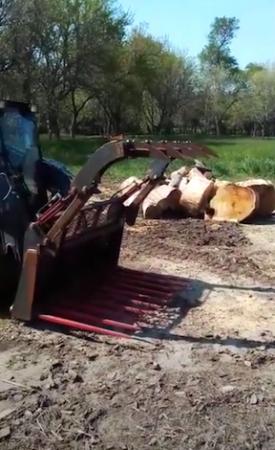
Paul Volk burns a lot of wood to heat his house, and he needed help gathering it. His reach and pull grapple piles brush, loads blocks and cordwood, and hauls it to the wood yard for processing.
“I looked at several reach-and-pull grapples, but they all had one feature or another I didn’t like, so I built my own,” says Volk. “I made my first sample out of cardboard, and it seemed to work, so I made my next one from 18-ga. metal, and the dimensions appeared to be correct. Then I started fabricating individual pieces and welding them together.”
With over 40 years of experience in welding and repairs alongside his farming, Volk had the skills he needed. When he needed help, he knew exactly where to find it.
“A local metal fabrication shop broke the bottom U for the tines and also the back plate,” says Volk. “The back is just over 62 in. wide and 24 in. high. It’s made from 1/4-in. sheet steel.”
He purchased the adapter plate from the local Bobcat dealer. The 48-in., bolt-in tines came from Parts4Farm. He used drawn-over-mandrel (DOM) tubing bored out on the lathe for sockets.
“The DOM goes through the U and is welded on both sides with a 1/2-in. bolt through the socket and the tine,” says Volk. “Initially, I used conventional tie rod cylinders with an 8-in. throw. I’ve since replaced them with grapple cylinders from Surplus Center with a 10-in. throw.”
The grapple teeth are made from 1/2-in. thick AR400 steel. He sourced the plate for the teeth at the machine shop and had it laser-cut to the pattern he provided.
“The teeth are welded to 1/2-in. plate and have two U-bolts for each tooth,” says Volk. “The brush guard is made from 2 by 1 by 11-gauge rectangular tube, covered by 1 1/2-in. #9 expanded metal.
“To my amazement, the grapple worked from the get-go. Other than changing some pin heights on the cylinder attaching points, I wouldn’t change a thing.”
Volk says the grapple gets a lot of use. It opens 62 in. to reach over and pull in large piles of brush.
“I tip the bucket forward and then close the grapple as I tip it back to pick up the brush,” says Volk. “When loading blocks, the tines slip underneath, and the grapple comes down. It holds the blocks so I can lift them away on the tines rather than bending some linkage.”
Contact: FARM SHOW Followup, Paul Volk, 54840 839th Rd., Battle Creek, Neb. 68715 (ph 402-675-1431; volkspec@volkracing.net).
